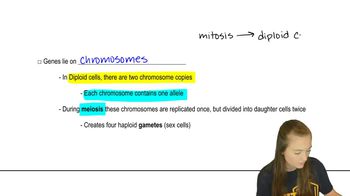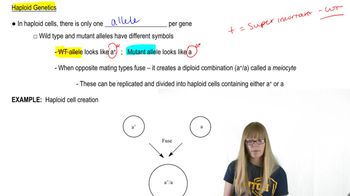Table of contents
- 1. Introduction to Genetics51m
- 2. Mendel's Laws of Inheritance3h 37m
- 3. Extensions to Mendelian Inheritance2h 41m
- 4. Genetic Mapping and Linkage2h 28m
- 5. Genetics of Bacteria and Viruses1h 21m
- 6. Chromosomal Variation1h 48m
- 7. DNA and Chromosome Structure56m
- 8. DNA Replication1h 10m
- 9. Mitosis and Meiosis1h 34m
- 10. Transcription1h 0m
- 11. Translation58m
- 12. Gene Regulation in Prokaryotes1h 19m
- 13. Gene Regulation in Eukaryotes44m
- 14. Genetic Control of Development44m
- 15. Genomes and Genomics1h 50m
- 16. Transposable Elements47m
- 17. Mutation, Repair, and Recombination1h 6m
- 18. Molecular Genetic Tools19m
- 19. Cancer Genetics29m
- 20. Quantitative Genetics1h 26m
- 21. Population Genetics50m
- 22. Evolutionary Genetics29m
2. Mendel's Laws of Inheritance
Inheritance in Diploids and Haploids
Problem 5a
Textbook Question
The diploid number of the hypothetical animal Geneticus introductus is 2n = 36. Each diploid nucleus contains 3 ng of DNA in G₁.
Complete the following table by entering the number of chromosomes and amount of DNA present per cell at the end of each stage listed.
End of Cell Cycle Number of Amount of
Stage Chromosomes DNA _
Telophase I
Mitotic telophase
Telophase II
 Verified step by step guidance
Verified step by step guidance1
<span>1. **Understand the Cell Cycle and Meiosis:** Begin by recognizing that the diploid number (2n) is 36, meaning there are 36 chromosomes in a diploid cell. Each diploid nucleus contains 3 ng of DNA in the G₁ phase. The stages mentioned (Telophase I, Mitotic Telophase, and Telophase II) are part of either mitosis or meiosis.</span>
<span>2. **Telophase I (Meiosis):** At the end of Telophase I, the cell has completed the first meiotic division. The homologous chromosomes have been separated, resulting in two haploid cells. Each cell will have half the number of chromosomes compared to the diploid number, so each cell will have 18 chromosomes. The amount of DNA will be the same as in G₁, which is 3 ng, because the DNA has not been replicated again.</span>
<span>3. **Mitotic Telophase (Mitosis):** At the end of mitotic telophase, the cell has completed mitosis, resulting in two identical diploid daughter cells. Each daughter cell will have the same number of chromosomes as the original diploid cell, which is 36 chromosomes. The amount of DNA in each daughter cell will be 3 ng, as the DNA content is restored to the G₁ level after cytokinesis.</span>
<span>4. **Telophase II (Meiosis):** At the end of Telophase II, meiosis is complete, resulting in four haploid cells. Each of these cells will have half the number of chromosomes compared to the diploid number, so each cell will have 18 chromosomes. The amount of DNA in each cell will be half of the G₁ amount, which is 1.5 ng, because the cells are haploid and have not undergone DNA replication after Telophase I.</span>
<span>5. **Summarize the Table:** Use the information from the previous steps to fill in the table: Telophase I - 18 chromosomes, 3 ng DNA; Mitotic Telophase - 36 chromosomes, 3 ng DNA; Telophase II - 18 chromosomes, 1.5 ng DNA.</span>
Recommended similar problem, with video answer:
 Verified Solution
Verified SolutionThis video solution was recommended by our tutors as helpful for the problem above
Video duration:
1mPlay a video:
Was this helpful?
Key Concepts
Here are the essential concepts you must grasp in order to answer the question correctly.
Diploid and Haploid Cells
Diploid cells contain two complete sets of chromosomes, one from each parent, denoted as 2n. In the case of Geneticus introductus, the diploid number is 36, meaning there are 36 chromosomes in somatic cells. During meiosis, diploid cells undergo division to produce haploid cells (n), which contain only one set of chromosomes, essential for sexual reproduction.
Recommended video:
Guided course

Diploid Genetics
Cell Cycle Stages
The cell cycle consists of several stages, including interphase and mitotic phases. Key stages relevant to the question are telophase I and II, which occur during meiosis, and mitotic telophase, which is part of mitosis. Each stage has distinct characteristics regarding chromosome number and DNA content, influencing how cells prepare for division and genetic variation.
Recommended video:
Guided course

Bacteriophage Life Cycle
DNA Content and Replication
DNA content refers to the amount of genetic material present in a cell, typically measured in nanograms (ng). In G₁ phase, Geneticus introductus has 3 ng of DNA per diploid cell. During the cell cycle, DNA replication occurs during the S phase, doubling the DNA content before cell division, which is crucial for ensuring that daughter cells receive the correct genetic information.
Recommended video:
Guided course

Steps to DNA Replication

 27:36m
27:36mWatch next
Master Diploid Genetics with a bite sized video explanation from Kylia Goodner
Start learningRelated Videos
Related Practice


